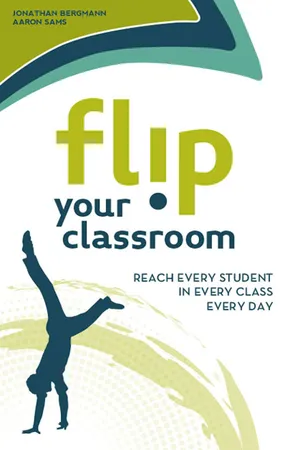
Flip Your Classroom
Reaching Every Student in Every Class Every Day
- English
- ePUB (mobile friendly)
- Available on iOS & Android
About this book
In this landmark text, flipped learning innovators Jonathan Bergmann and Aaron Sams share what a flipped classroom is and why it works, and provide the information you need to successfully flip a classroom. It started with a simple observation: Students need their teachers present to answer questions or to provide help if they get stuck on an assignment; they don't need their teachers present to listen to a lecture or review content. From there, Bergmann and Sams began the flipped classroom: Students watched recorded lectures for homework and completed their assignments, labs and tests in class with their teacher available. What Bergmann and Sams found was that their students demonstrated a deeper understanding of the material than ever before. This is the authors' story, and they're confident it can be yours too.With this book, you'll learn the flipped mastery model, where students learn at their own pace, furthering opportunities for personalized education. This simple concept is easily replicable in any classroom, doesn't cost much to implement and helps foster self-directed learning. Once you flip, you won't want to go back!Features include:
- An argument for and overview of the flipped and flipped mastery classrooms
- The logistics of conducting a flipped classroom, from the equipment needed to create videos to what to do during class to student assessment
- An FAQ section that addresses computer access, administrator buy-in and making sure students are reliably accessing content on their own time
Copublished by ASCD and ISTE. Audience: K-12 classroom
Frequently asked questions
- Essential is ideal for learners and professionals who enjoy exploring a wide range of subjects. Access the Essential Library with 800,000+ trusted titles and best-sellers across business, personal growth, and the humanities. Includes unlimited reading time and Standard Read Aloud voice.
- Complete: Perfect for advanced learners and researchers needing full, unrestricted access. Unlock 1.4M+ books across hundreds of subjects, including academic and specialized titles. The Complete Plan also includes advanced features like Premium Read Aloud and Research Assistant.
Please note we cannot support devices running on iOS 13 and Android 7 or earlier. Learn more about using the app.
Information
Chapter 1
OUR STORY:
Creating THE
Flipped Classroom
Background
The Flipped Classroom Is Born
How Flipping Aids Personalization
The Flipped Classroom Grows
The Flipped Mastery Class Begins
Are You Ready to Flip?
Table of contents
- Cover
- Title Page
- Copyright
- About ISTE
- About the Authors
- Acknowledgment
- Dedication
- Contents
- Foreword by Karl Fisch
- Chapter 1: Our Story: Creating The Flipped Classroom
- Chapter 2: The Flipped Classroom
- Chapter 3: Why You Should Flip Your Classroom
- Chapter 4: How to Implement the Flipped Classroom
- Chapter 5: The Flipped-Mastery Classroom
- Chapter 6: The Case for the Flipped-Mastery Model
- Chapter 7: How to Implement the Flipped-Mastery Model
- Chapter 8: Answering Your Questions (FAQs)
- Chapter 9: Conclusion